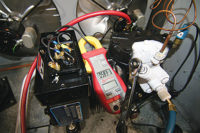 HVACR field service terminology is often confusing and misused even by the most seasoned of veterans. But clarification of such terminology among service technicians is of the utmost importance in order to clarify the real problem and efficiently find the correct remedy. Clear, concise, and accurate communication between service technicians, parts suppliers, customers, and the home shop is rapidly gaining importance as the HVACR field transitions and becomes more technically oriented.
HVACR field service terminology is often confusing and misused even by the most seasoned of veterans. But clarification of such terminology among service technicians is of the utmost importance in order to clarify the real problem and efficiently find the correct remedy. Clear, concise, and accurate communication between service technicians, parts suppliers, customers, and the home shop is rapidly gaining importance as the HVACR field transitions and becomes more technically oriented.
My column in the July 1, 2013 issue of The NEWS covered refrigerant migration and how it can damage the compressor’s mechanical parts. It also covered remedies to migration using automatic pump down systems. This month’s article will cover flooding and slugging of compressors.
Two important service terms that are often misunderstood and misused by service technicians are flooding and slugging. Here’s how they apply to refrigeration and air conditioning compressors.
Flooding
Flooding is liquid refrigerant entering the compressor’s crankcase while the compressor is running. Flooding occurs to a compressor only during the on cycle.
Causes are:
• Wrong TXV setting (no compressor superheat);
• Overcharge;
• Evaporator fan out;
• Low load on evaporator;
• End of cycle (lowest load);
• Defrost clock or heater out (iced coil);
• Dirty or blocked evaporator coil;
• Capillary tube overfeeding;
• Capillary tube system overcharged;
• Expansion bulb loose on evaporator outlet;
• Oversized expansion valve;
• Flooding after hot gas termination;
• Heat pump changeover; or
• Defrost termination.
Since liquid refrigerants are heavier than refrigeration oils, liquid refrigerant returning to the compressor will settle under the oil in the bottom of the compressor’s crankcase. This liquid refrigerant will gradually be boiled off from the low pressures in the crankcase. However, since the liquid refrigerant being boiled off is under the oil in the crankcase, very small oil particles will be entrained in this vaporization process. The oil level in the crankcase will now drop and rob mechanical parts of vital lubrication. Often, refrigerant-cooled semi-hermetic compressors have check valves located on a partition between the crankcase and motor barrel to prevent oil and liquid refrigerant from mixing. Air-cooled semi-hermetic compressors and hermetic compressors are often more prone to flooding. Suction accumulators can help a flooding condition, but if the situation is severe, accumulators can also flood.
Crankcase pressures can become excessively high from liquid refrigerant boiling in the crankcase. These high crankcase pressures can cause refrigerant and entrained oil particles to escape around the rings of the pistons during its down stroke. Once in the compressor’s cylinders, they will be pumped by the compressor into the discharge line. The compressor is now pumping oil and refrigerant, and robbing the crankcase of lubrication.
Oil in the system and not in the crankcase will coat the inner walls of the tubing and valves and cause unwanted inefficiencies. Higher than normal crankcase pressures caused from the higher-density refrigerant and oil mixture being pumped through the compressor’s cylinders will cause high compressor current draw. This may overheat and even trip the compressor. Broken valves can also occur from this phenomenon.
A telltale sign that a compressor’s crankcase is being flooded with refrigerant will be a cold, frosted, or sweaty crankcase. A foaming compressor’s oil sight glass with a low oil level is also a sign of flooding. Higher than normal current draws will also be present.
Slugging
Slugging is liquid refrigerant, or liquid refrigerant and oil, entering the compressor’s cylinder during an on cycle.
Causes are:
• No compressor superheat;
• Migration (off cycle);
• Bad TXV;
• TXV hunting;
• Low load;
• End of cycle (lowest load);
• Evaporator fan out;
• Iced evaporator coil;
• Defrost timer or heater out;
• Dirty evaporator;
• Capillary tube overfeeding; or
• Overcharge.
Air-cooled semi-hermetic compressors are more prone to slugging liquid than refrigerant cooled semi-hermetic compressors. This is because refrigerant is often drawn directly into an air-cooled semi-hermetic compressor’s cylinder without passing through the motor barrel. Slugging can result in broken valves, broken head gaskets, broken connecting rods, and other major compressor damage.
Refrigerant-cooled semi-hermetic compressors will often draw liquid from the suction line through hot motor windings in the motor barrel that assist in vaporizing any liquid. Even if liquid refrigerant gets past the motor windings, the check valve in the partition between the crankcase and the motor barrel will prevent any liquid refrigerant from entering the crankcase. High current draws will be noticed here from dense refrigerant vapors entering the compressor’s cylinder.
Most hermetic compressors’ suction lines end at the shell of the compressor. If liquid refrigerant is entering the compressor, liquid will fall directly into the crankcase oil and eventually be flashed. As mentioned earlier, this is referred to as flooding. This causes oil foaming and excessively high crankcase pressures. Refrigerant and oil droplets will soon reach the compressor’s cylinder and slugging will soon occur.
Slugging in hermetic compressors can also occur from a migration problem. As mentioned before, foaming oil and refrigerant in the crankcase due to migration will generate excessive crankcase pressures when the on-cycle occurs. These oil and refrigerant droplets can now get past piston rings and other small openings and enter the compressor’s cylinder. The end result is slugging of refrigerant and oil. Slugging can damage valves, piston rods, bearings, and many more mechanical parts.
Clarification and understanding of these two technical terms can help technicians troubleshoot and remedy even the most complex compressor breakdowns.
Publication date: 8/5/2013
Want more HVAC industry news and information? Join The NEWS on Facebook, Twitter, and LinkedIn today!










